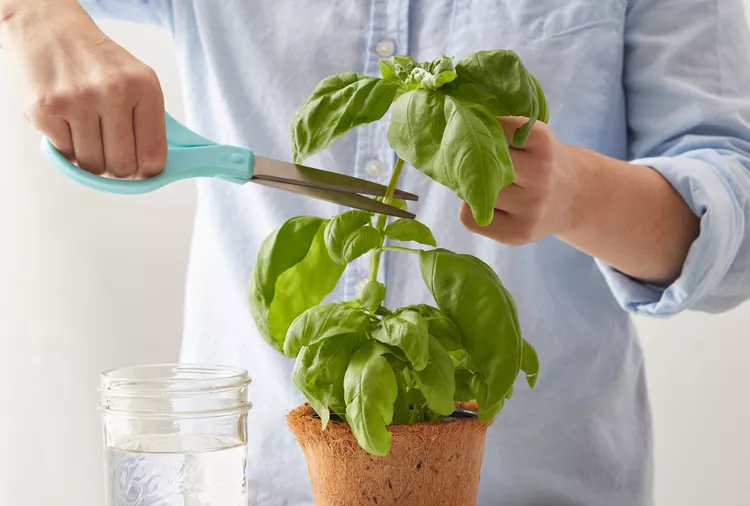Although basil can grow perennially in warm areas, most gardeners cultivate the herb as an annual and grow new plants from seed every spring. However, if you want to harvest fresh basil earlier or keep basil plants indoors during the winter, you can propagate cuttings of sweet basil and other basil varieties in soil or water. Growing basil from cuttings is easy. In about half the time it takes the plants to grow from seed, you’ll have fresh herbs for pesto and other hearty fare.
Basil Propagation Tips
Basil plants can be propagated throughout the growing season, but taking cuttings before the first frost of autumn and rooting them indoors is an easy way to create a winter supply of basil. For best results, take cuttings from healthy stems.
Avoid propagating plants that are actively flowering. Flowering consumes a lot of plant energy, and stems that are blooming won’t root well.
When taking cuttings, cut the stem directly above a leaf node on the plant. Always use sterilized pruners or scissors to reduce the chances of disease as you take your cuttings. If you want to propagate fresh basil from the grocery store, trim the herb stems back to a leaf node so it’s easier for the cut stems to absorb water.
How to Propagate Basil in Soil
Rooting in soil takes a little longer than water propagation, but it usually produces plants with sturdier root systems. Even better, if you propagate basil in a roomy pot, you may not need to transplant it later.
1. Take basil cuttings.
Using a sharp, sterilized pair of scissors or pruners, take 4- to 6-inch-long stem cuttings from a healthy basil plant by cutting stems on a slight angle above a leaf node. Some cuttings may not root, so take a few more cuttings than you think you need.
2. Remove the lower leaves.
Carefully pinch or clip away any leaves that are growing on the bottom third of the cutting stems. Basil roots quickly, so there’s no need to treat the stems with rooting hormone.
3. Prepare the planting pot.
Fill a small, 4- to 6-inch-diameter pot with pre-moistened potting mix. Using a pencil or your pinky finger, poke planting holes in the potting mix where you intend to plant the basil cuttings.
4. Plant the cuttings.
Position the stem cuttings in the premade planting holes so that the bottom 1 to 2 inches of the basil stems are buried and the leaves are comfortably above the soil line. Roots will develop from the nodes, so make sure at least a couple of notes are below the soil. Firm the soil around the base of the cuttings to keep them upright, and cover the top of the cuttings and pot with a clear plastic baggie to lock in humidity. Move the cuttings to a spot where they’ll receive bright, indirect light, and mist them regularly to keep the soil evenly moist but not soggy.
Several cuttings can be planted together in a 6-inch pot; however, 4-inch pots can hold only a single basil cutting or two.
5. Wait for the roots to develop.
It takes about two to four weeks for basil cuttings to root in soil. You’ll know the cuttings have rooted when they begin to produce new growth and can’t be easily lifted from the soil when you gently tug on the stem. After rooting, the cuttings can be kept in their original pots, transplanted into larger containers, or hardened off and transplanted outside into garden beds.
How to Propagate Basil in Water
Basil roots faster in water than soil, but you must ensure the basil leaves don’t fall into the propagation water and start to rot. Using a clear glass or plastic propagation container can make it much easier to keep track of the water line and see when basil roots begin to sprout.
1. Take basic cuttings.
Cut several 4- to 6-inch-long stem cuttings from healthy basil plants using scissors or a sharp knife. Make the cuts at a slight angle just above a leaf node.
2. Remove the lower leaves.
Gently strip away any leaves growing on the bottom third of the basil cuttings to prevent leaves from sitting below the water line while the cuttings propagate.
3. Place the cuttings in water.
Fill a clear glass or plastic jar or cup with enough water so that the cut basil stems are fully submerged but the leaves are above the water line. Move the cuttings under a grow light or into a spot that receives bright, indirect light.
4. Wait for the roots to develop.
When basil is propagated in water, cuttings should start to root in about two weeks. While you wait for roots to sprout, refresh the water in your propagation container every one or two days and make sure the water never dries up or turns cloudy.
5. Transplant the rooted cuttings into soil.
Once the basil roots are 1 to 2 inches long, transplant the rooted cuttings into pots filled with a rich potting mix or out into your garden after a period of hardening off. After transplanting, care for new basil starts like mature basil plants.




















